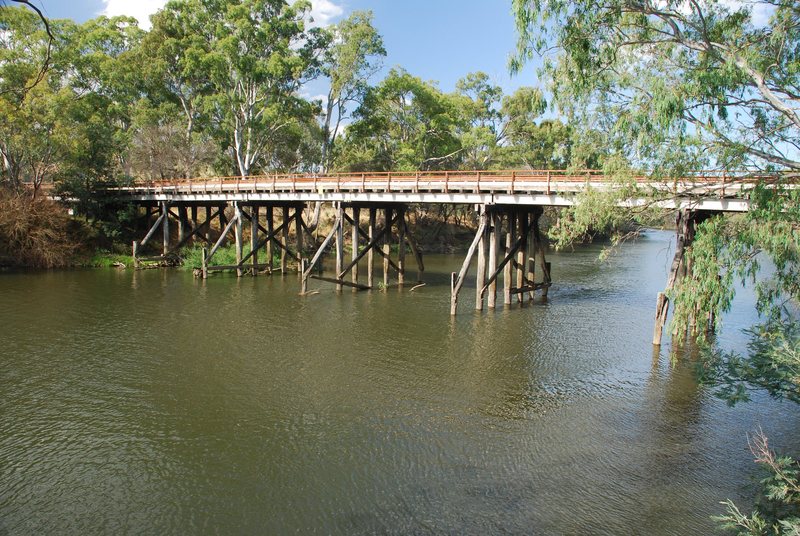OLD GOULBURN RIVER BRIDGE
OLD HUME HIGHWAY SEYMOUR, MITCHELL SHIRE
-
Add to tour
You must log in to do that.
-
Share
-
Shortlist place
You must log in to do that.
- Download report









Statement of Significance
What is significant?
The Old Goulburn River Bridge is a composite timber trestle and metal road bridge on the Old Hume Highway at Seymour. The bridge has 7-pile timber piers and nine spans with a maximum span length of 12 metres. The longitudinally-timbered timber deck is 105 metres in length supported by timber cross beams on 24-inch rolled steel joists.
The bridge spans the crossing place of the Goulburn River on the historic Sydney Road, in use since a Victorian Government punt began operating at the site in 1853. The first timber bridge was constructed in 1862, replaced in 1892 by a new timber bridge constructed by J.B. Farquharson and designed by Shire Engineer, Mr Renou. The bridge was unusual for the use of grey box piers and was the last big-river timber bridge built prior to the economic depression of 1893 after which special State funding for big river bridge projects was withdrawn. When opened in 1892 it was regarded as a superior and extravagantly-expensive structure.
In 1933 the bridge was the first of the main road bridges to be reconstructed under the Country Road Boards' redevelopment of the interstate route, renamed the Hume Highway in 1926. A steel joist and timber superstructure was added to the 1892 grey box substructure.This composite bridge served until the Hume Highway was diverted in 1966. The bridge was closed to vehicular traffic in 1987 and incorporated into a recreation reserve and walking track. Fire has since damaged the deck and the bridge is now closed to all traffic. The remainder of the bridge is in a sound and largely intact, although there is uncertainty about the under water structure.
How is it significant?
The Old Goulburn River Bridge, Seymour is of historic, scientific (technological) and aesthetic significance to the State of Victoria.
Why is it significant?
The Old Goulburn River Bridge is of historic significance for its association with one of Victoria's most important river crossings from 1853 until the diverting of the Hume Highway in 1966.
The Old Goulburn River Bridge is of historical significance in representing two major phases of road bridge construction in Victoria, being the last of the extravagant large timber road bridges of the 19th century and the oldest and most authentic surviving example of a large composite highway bridge of the new motor-vehicle pattern introduced by the Country Roads Board during the Great Depression era.
The Old Goulburn River Bridge has scientific (technical) significance as a rare, well-preserved example of 19th century timber road-bridge construction and is one of four colonial timber bridges constructed on the Goulburn River from 1889-95. The others are Kirwans Bridge (1890, H1886), Chinamans Bridge (1891, H1449) and Mitchellstown Bridge (1895). The design of each varies but all were 'over-built' and collectively they represent a final brief flowering of traditional European pattern-book road bridge construction. However the use of grey box in the substructure of the Old Goulburn River Bridge reflects a significant local innovation in the use of Australian timbers. The strength and durability of the grey box enabled retention of the original substructure in the CRB's reconstruction of the bridge in 1933. The Old Goulburn River Bridge is also significant for its association with J.B. Farquharson who constructed Chinamans Bridge (H1449) and several lift-span and timber truss bridges over the Murray River.
The Old Goulburn River Bridge has scientific (technical) significance as a now rare example of the CRB highway bridges that were built to a far greater strength than other bridges. The use of rolled steel joists and replacement of the traditional transversely planked timber deck with a longitudinally planked deck supported on crossbeams represented the new CRB standard bridge design.
The Old Goulburn River Bridge is of aesthetic significance for its elegant timber structure and native bush setting on the fast-flowing and broad Goulburn River. Several large river Red Gums alongside the approaches to the bridge provide a picturesque context for the bridge.
-
-
OLD GOULBURN RIVER BRIDGE - Permit Exemptions
General Exemptions:General exemptions apply to all places and objects included in the Victorian Heritage Register (VHR). General exemptions have been designed to allow everyday activities, maintenance and changes to your property, which don’t harm its cultural heritage significance, to proceed without the need to obtain approvals under the Heritage Act 2017.Places of worship: In some circumstances, you can alter a place of worship to accommodate religious practices without a permit, but you must notify the Executive Director of Heritage Victoria before you start the works or activities at least 20 business days before the works or activities are to commence.Subdivision/consolidation: Permit exemptions exist for some subdivisions and consolidations. If the subdivision or consolidation is in accordance with a planning permit granted under Part 4 of the Planning and Environment Act 1987 and the application for the planning permit was referred to the Executive Director of Heritage Victoria as a determining referral authority, a permit is not required.Specific exemptions may also apply to your registered place or object. If applicable, these are listed below. Specific exemptions are tailored to the conservation and management needs of an individual registered place or object and set out works and activities that are exempt from the requirements of a permit. Specific exemptions prevail if they conflict with general exemptions. Find out more about heritage permit exemptions here.Specific Exemptions:General Conditions: 1. All exempted alterations are to be planned and carried out in a manner which prevents damage to the fabric of the registered place or object. General Conditions: 2. Should it become apparent during further inspection or the carrying out of works that original or previously hidden or inaccessible details of the place or object are revealed which relate to the significance of the place or object, then the exemption covering such works shall cease and the Executive Director shall be notified as soon as possible. Note: All archaeological places have the potential to contain significant sub-surface artefacts and other remains. In most cases it will be necessary to obtain approval from Heritage Victoria before the undertaking any works that have a significant sub-surface component. General Conditions: 3. If there is a conservation policy and plan approved by the Executive Director, all works shall be in accordance with it. Note: The existence of a Conservation Management Plan or a Heritage Action Plan endorsed by Heritage Victoria provides guidance for the management of the heritage values associated with the site. It may not be necessary to obtain a heritage permit for certain works specified in the management plan. General Conditions: 4. Nothing in this determination prevents the Executive Director from amending or rescinding all or any of the permit exemptions. General Conditions: 5. Nothing in this determination exempts owners or their agents from the responsibility to seek relevant planning or building permits from the responsible authorities where applicable. Regular Site Maintenance : The following site maintenance works are permit exempt under section 66 of the Heritage Act 1995, a) regular site maintenance provided the works do not involve the removal or destruction of any significant above-ground features or sub-surface archaeological artefacts or deposits; b) the maintenance of an item to retain its conditions or operation without the removal of or damage to the existing fabric or the introduction of new materials; c) cleaning including the removal of surface deposits, organic growths, or graffiti by the use of low pressure water and natural detergents and mild brushing and scrubbing; d) repairs, conservation and maintenance to plaques, memorials, roads and paths, fences and gates and drainage and irrigation. e) the replacement of existing services such as cabling, plumbing, wiring and fire services that uses existing routes, conduits or voids, and does not involve damage to or the removal of significant fabric. Note: Surface patina which has developed on the fabric may be an important part of the item’s significance and if so needs to be preserved during maintenance and cleaning. Note: Any new materials used for repair must not exacerbate the decay of existing fabric due to chemical incompatibility, obscure existing fabric or limit access to existing fabric for future maintenance. Repair must maximise protection and retention of fabric and include the conservation of existing details or elements. Fire Suppression Duties : The following fire suppression duties are permit exempt under section 66 of the Heritage Act 1995, a) Fire suppression and fire fighting duties provided the works do not involve the removal or destruction of any significant above-ground features or sub-surface archaeological artefacts or deposits; b) Fire suppression activities such as fuel reduction burns, and fire control line construction, provided all significant historical and archaeological features are appropriately recognised and protected; Note: Fire management authorities should be aware of the location, extent and significance of historical and archaeological places when developing fire suppression and fire fighting strategies. The importance of places listed in the Heritage Register must be considered when strategies for fire suppression and management are being developed. Weed and Vermin Control : The following weed and vermin control activities are permit exempt under section 66 of the Heritage Act 1995, a) Weed and vermin control activities provided the works do not involve the removal or destruction of any significant above-ground features or sub-surface archaeological artefacts or deposits; Note: Particular care must be taken with weed and vermin control works where such activities may have a detrimental affect on the significant fabric of a place. Such works may include the removal of ivy, moss or lichen from an historic structure or feature, or the removal of burrows from a site that has archaeological values. Landscape Maintenance : The following landscape maintenance works are permit exempt under section 66 of the Heritage Act 1995, a) landscape maintenance works provided the activities do not involve the removal or destruction of any significant above-ground features or sub-surface archaeological artefacts or deposits; b) watering, mowing, top-dressing and fertilising necessary for the continued health of plants, without damage or major alterations to layout, contours, plant species or other significant landscape features; c) Repairs, conservation and maintenance to hard landscape elements, buildings, structures, ornaments, roads and paths, drainage and irrigation system.d) Management of trees in accordance with Australian Standard; Pruning of amenity trees AS4373.e) Removal of plants listed as noxious weeds in the Catchment and Land Protection Act 1994. f) Installation, removal or replacement of garden watering and drainage systems.g) Non-structural works that occur at a distance greater than 5 metres from the canopy edge of a significant tree, plant or hedge, (structural works may require a permit if still on the registered land). Public Safety and Security : The following public safety and security activities are permit exempt under section 66 of the Heritage Act 1995, a) public safety and security activities provided the works do not involve the removal or destruction of any significant above-ground structures or sub-surface archaeological artefacts or deposits; b) the erection of temporary security fencing, scaffolding, hoardings or surveillance systems to prevent unauthorised access or secure public safety which will not adversely affect significant fabric of the place including archaeological features; c) development including emergency stabilisation necessary to secure safety where a site feature has been irreparably damaged or destabilised and represents a safety risk to its users or the public. Note: Urgent or emergency site works are to be undertaken by an appropriately qualified specialist such as a structural engineer, or other heritage professional. Signage and Site Interpretation : The following Signage and Site Interpretation activities are permit exempt under section 66 of the Heritage Act 1995, a) signage and site interpretation activities provided the works do not involve the removal or destruction of any significant above-ground structures or sub-surface archaeological artefacts or deposits; b) the erection of non-illuminated signage for the purpose of ensuring public safety or to assist in the interpretation of the heritage significance of the place or object and which will not adversely affect significant fabric including landscape or archaeological features of the place or obstruct significant views of and from heritage values or items; c) signage and site interpretation products must be located and be of a suitable size so as not to obscure or damage significant fabric of the place; d) signage and site interpretation products must be able to be later removed without causing damage to the significant fabric of the place; Note: The development of signage and site interpretation products must be consistent in the use of format, text, logos, themes and other display materials. Note: Where possible, the signage and interpretation material should be consistent with other schemes developed on similar or associated sites. It may be necessary to consult with land managers and other stakeholders concerning existing schemes and strategies for signage and site interpretation. Minor Works : Note: Any Minor Works that in the opinion of the Executive Director will not adversely affect the heritage significance of the place may be exempt from the permit requirements of the Heritage Act. A person proposing to undertake minor works may submit a proposal to the Executive Director. If the Executive Director is satisfied that the proposed works will not adversely affect the heritage values of the site, the applicant may be exempted from the requirement to obtain a heritage permit. If an applicant is uncertain whether a heritage permit is required, it is recommended that the permits co-ordinator be contacted.OLD GOULBURN RIVER BRIDGE - Permit Exemption Policy
It is the purpose of the permit exemptions to enable routine maintenance and repairs which do not damage the significant fabric of the place, or diminish its cultural significance. Few alterations could be made to the bridge without compromising appreciation of the bridge's design. Old Goulburn River Bridge is significant for the method of its construction and its grey box timber piles. Any proposed works that would replace or alter the fabric of the structure, or adversely affect any understanding of it should be avoided. A permit will be required for any substantial alterations.
-
-
-
-
-
Old Hume Highway Bridge
 National Trust H0092
National Trust H0092 -
New Crossing Place, Seymour
 National Trust
National Trust -
Seymour Military Store Sheds and Camp
 Vic. War Heritage Inventory
Vic. War Heritage Inventory
-
'CARINYA' LADSONS STORE
 Victorian Heritage Register H0568
Victorian Heritage Register H0568 -
1 Alexander Street
 Yarra City
Yarra City -
1 Botherambo Street
 Yarra City
Yarra City
-
-










